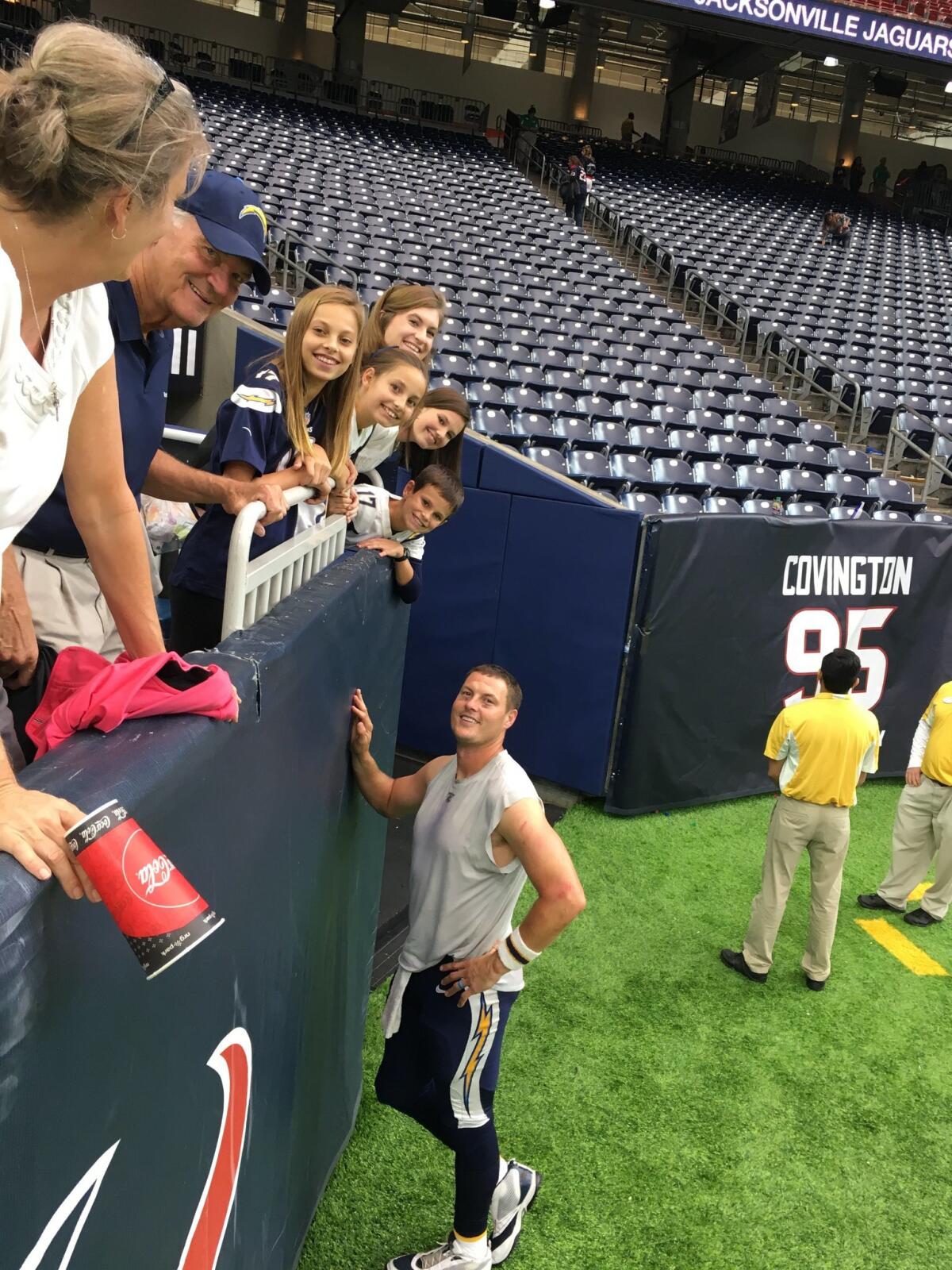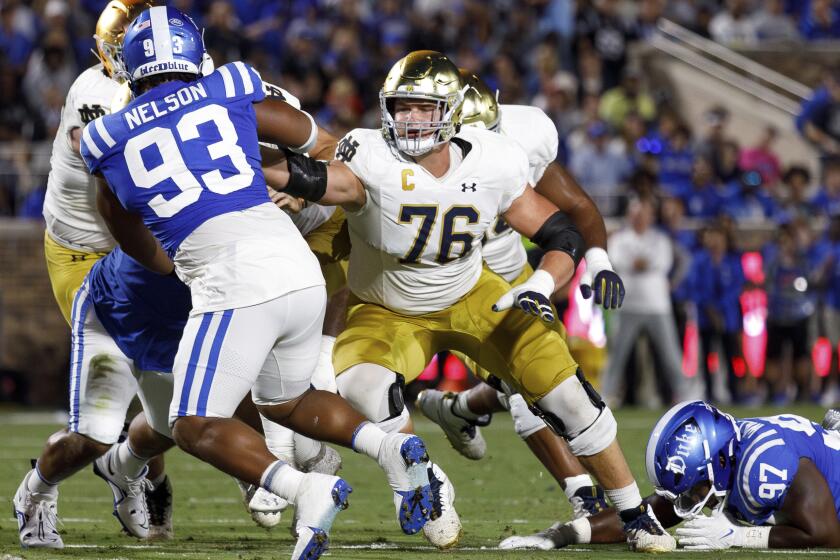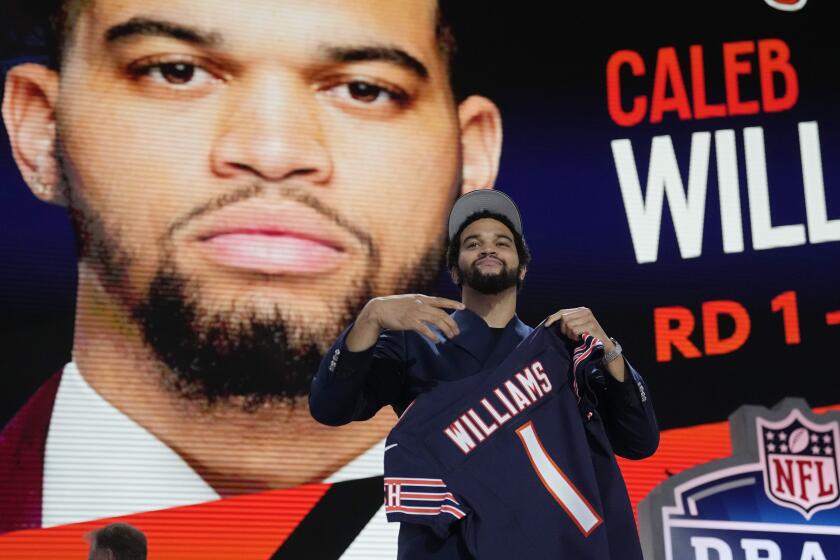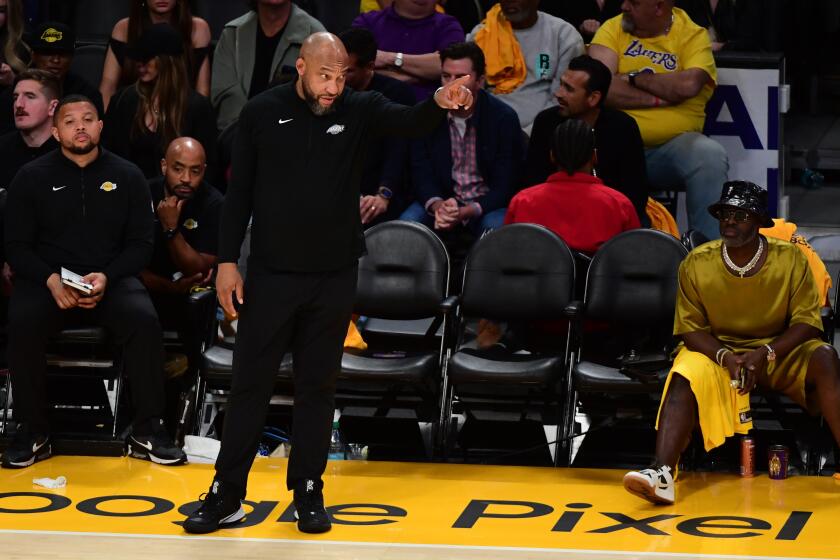No kidding, Chargers quarterback Philip Rivers made his NFL dreams come true
Philip Rivers didn’t like mayonnaise or Brussels sprouts. He wanted a younger brother and good grades. And, like so many 10-year-olds across the country, he dreamed about suiting up for an NFL team.
All that is memorialized in a yellowed school project that’s framed in the basement of his parents’ modest home in Decatur, Ala. The handwritten poster is entitled “All About Me…” and it’s a Canton-worthy artifact, featuring the cherubic face of young Philip superimposed onto a photo of striding Minnesota Vikings star Cris Carter on a Sports Illustrated magazine cover.
Now that is a vision board.
From basement dreams to stratospheric reality, Rivers has ascended to the top of the game, last Sunday joining Brett Favre and brothers Peyton and Eli Manning as the only quarterbacks to start 200 consecutive games. He’s having a tremendous season for the 6-2 Chargers, undeniably playing his way into the NFL Most Valuable Player conversation.
Although they won’t be in Oakland for Sunday’s game, Joan and Steve Rivers travel to several Chargers games each year and are relishing their son’s 16th season in the league.
“They know it’s the homestretch in a sense,” Rivers said. “Hopefully, there are a handful more [seasons]. They want to see as many as they can.”
Rivers, 36, and wife Tiffany were junior high sweethearts in Alabama, and have eight children. They opted to stay in San Diego when the Chargers moved north, and Philip commutes 70 miles each way to practice, in a full-outfitted SUV that allows him to study video while he’s driven.

Steve and Joan gave serious thought to moving to San Diego in 2004 when Philip was a rookie. They had younger children — Stephen, 11, and Anna, 6 — and were thinking that Steve would coach high school football, as he did in Alabama and North Carolina (when Philip was at North Carolina State). But the yearning for their hometown was too strong.
“We ended up staying about six weeks, but Joan and I finally said, ‘We’ve got to go back home,’” Steve said. “I couldn’t believe the traffic. I mean, it’s beautiful, wonderful, awesome, nothing bad to say. It’s just different for a small-town guy. When I say traffic, I mean all lanes. I couldn’t get over it. At 10 o’clock at night there was traffic. At 10 o’clock at night in Decatur, Alabama, people are watching the nightly news and getting ready for bed.”
Close your eyes and listen to Steve, and he sounds almost identical to Philip. Same soft drawl. Same homespun expressions and self-effacing wit. He was a quarterback and defensive back at Mississippi State, his college career mostly derailed early because of a knee injury.
“I was maybe an above-average athlete, but I had no business being in the SEC,” he said. “But Mississippi State was really low. I was doing well the spring of my sophomore year, and I tore my knee up. Back then, 1968, ’69, rehab was they put a hard cast on you from the top of your leg to your toes for six weeks.
“I was fast like Philip,” he said with a chuckle. “Then I got the cast on, and I was really fast like Philip.”
Philip wasn’t quick, but he was a quick study. He was obsessed with the game, helping his dad as a ball boy for the high school team for years before he played there. When the chain gang would come onto the field for a measurement, young Philip would wriggle his way into the officials’ huddle and hold his hands apart toward the sideline to signal exactly how much was required for a first down.
“I felt like I could contribute,” he said. “I felt like they really needed me to tell them if it was a foot or two feet.”
A penchant for leadership surfaced early in Rivers, who used to pop to his feet at high school basketball games when he was 4 or 5 and theatrically wave his arms as if conducting the pep band.
“It’s so funny, me looking back now,” he said. “I remember asking my mom, ‘Can you be the quarterback and the drum major at halftime?’ I mean it’s like, what in the world? I wanted to go play quarterback, and I wanted to lead the band. I don’t know how old I was but I vaguely remember asking them that.”
On the field, Rivers is a traffic cop before the snap, directing teammates this way and that. He has passed for 19 touchdowns in eight games, tied for the second-highest total of his career at the midway point. Seven times Rivers has posted a passer rating of 100 or more, a personal high in the first eight games of a season.
“He’s just on his game, man,” running back Melvin Gordon told reporters after Sunday’s victory at Seattle. “Phil, he’s a guru at this. He plays chess out there. He knows what’s going on. He knows where guys are going to be, studies film like crazy. I watch him all the time, so this is expected from Phil.”
Dozens of quarterbacks have put a good season or two together, but precious few have shown the longevity, durability and sustained excellence of Rivers. Good fortune is a part of that, and so is toughness. Rivers famously gritted through a torn ACL to keep the Chargers in the hunt at New England in the 2007 AFC championship game. It was a two-point game through three quarters before the Patriots pulled away in the fourth for a 21-12 victory.

Rivers got significantly tougher during his sophomore year of high school when, because a senior was starting at quarterback, he was moved to weakside linebacker.
“I really grew as a football player that year, definitely in the toughness department,” he said. “Even when they threw me in there, early on I was a little shocked with the contact. Not so much scared, but you’re taking on a fullback running right at you. I learned a lot. I enjoyed that.”
Rivers got a lot of his competitiveness from his mom, who flashes it even when playing board games with her grandchildren. And he figures he developed his somewhat unorthodox throwing style — he delivers the ball from all sorts of arm angles — from all those years as a ball boy for his dad.
“When I wasn’t needed to spot the ball at practice, or whatever else I was needed to do, me and the other coaches’ sons were throwing the football,” he said. “It was a varsity regular-sized ball, and I was 8 years old. The only way you could throw it was kind of lay it in your hand and kind of push it. So I think that’s where it started.”
During his freshman year at North Carolina State, Rivers was coached by Norm Chow, who contemplated tinkering with his throwing motion. Chow sent a tape of the young quarterback to a fellow passing guru, Mike Holmgren, who weighed in with an opinion.
“I wouldn’t touch it,” Holmgren said. “He gets it where it’s supposed to be going. On time.”
The same might be said of Rivers’ NFL career, the one he pined for so long ago. Perfect? No. But he’s gotten where he’s supposed to be going.
Follow Sam Farmer on Twitter @LATimesfarmer
Get our high school sports newsletter
Prep Rally is devoted to the SoCal high school sports experience, bringing you scores, stories and a behind-the-scenes look at what makes prep sports so popular.
You may occasionally receive promotional content from the Los Angeles Times.




